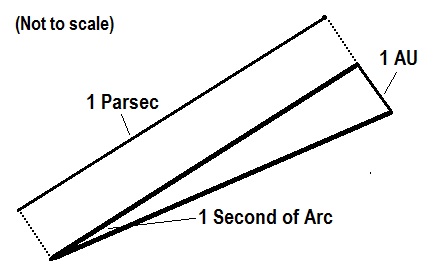Difference between revisions of "Parsec"
| Line 1: | Line 1: | ||
| − | |||
A '''Parsec''' (symbol: pc) is a unit of length, used to measure the distance between stars. | A '''Parsec''' (symbol: pc) is a unit of length, used to measure the distance between stars. | ||
| Line 7: | Line 6: | ||
{{Metadata}} | {{Metadata}} | ||
| − | + | ||
The Solomani define one parsec to be the distance from the Terra to a star that has a parallax of 1 arcsecond, and equals 3.261 [[light-year]]s or 206,265 Astronomical units. By coincidence this distance is very close to the maximum distance a jump-1 drive can jump. Because of this, 'parsec' has become the standard word used for this distance within the {{Imperium}}. | The Solomani define one parsec to be the distance from the Terra to a star that has a parallax of 1 arcsecond, and equals 3.261 [[light-year]]s or 206,265 Astronomical units. By coincidence this distance is very close to the maximum distance a jump-1 drive can jump. Because of this, 'parsec' has become the standard word used for this distance within the {{Imperium}}. | ||
Other races, using the orbital distance of their home world and different definitions of an arc second would derive different values for a parsec, but these wouldn't be Imperial parsecs. | Other races, using the orbital distance of their home world and different definitions of an arc second would derive different values for a parsec, but these wouldn't be Imperial parsecs. | ||
| − | == | + | No information or synopsis yet available. |
| − | + | ||
| + | == Description (Specifications) == | ||
| + | No information yet available. | ||
| + | |||
| + | == History & Background (Dossier) == | ||
| + | No information yet available. | ||
| − | == | + | == References & Contributors (Sources) == |
{{Wikipedia|Parsec}} | {{Wikipedia|Parsec}} | ||
| + | {{Sources | ||
| + | |S1= Author & Contributor: Lord (Marquis) and Master of Sophontology [[User:Maksim-Smelchak|Maksim-Smelchak]] of the [[Ministry of Science]] | ||
| + | |S2= | ||
| + | |S3= | ||
| + | |S4= | ||
| + | }} | ||
| + | |||
{{DE|P|Astrography|Unit of measurement}} | {{DE|P|Astrography|Unit of measurement}} | ||
Revision as of 15:39, 27 January 2016
A Parsec (symbol: pc) is a unit of length, used to measure the distance between stars.
The name parsec stands for "parallax of one second of arc", and allows calculating distances to nearby stars using simple observation and trigonometric parallax (apparent motion of an object due to change of position of the observer). It is one of the oldest Terran methods for measuring the distances to stars. A parsec is based on a baseline of 1 Astronomical unit.
| This article has metadata. |
The Solomani define one parsec to be the distance from the Terra to a star that has a parallax of 1 arcsecond, and equals 3.261 light-years or 206,265 Astronomical units. By coincidence this distance is very close to the maximum distance a jump-1 drive can jump. Because of this, 'parsec' has become the standard word used for this distance within the Imperium.
Other races, using the orbital distance of their home world and different definitions of an arc second would derive different values for a parsec, but these wouldn't be Imperial parsecs.
No information or synopsis yet available.
Description (Specifications)
No information yet available.
History & Background (Dossier)
No information yet available.
References & Contributors (Sources)
| This page uses content from Wikipedia. The original article was at Parsec. The list of authors can be seen in the page history. The text of Wikipedia is available under the Commons Attribution-ShareAlike 3.0 Unported License. |
- Author & Contributor: Lord (Marquis) and Master of Sophontology Maksim-Smelchak of the Ministry of Science
